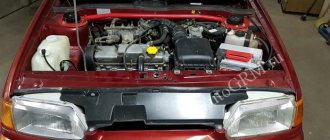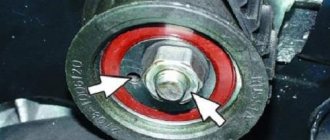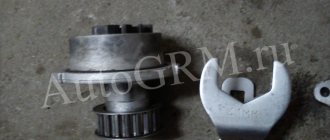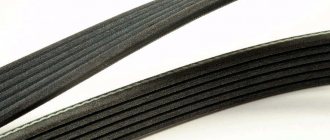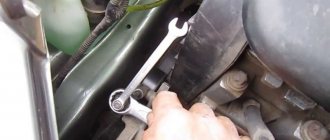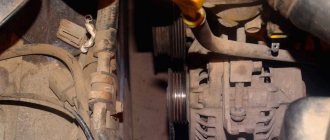Operation of the Kia Spectra is accompanied by gradual wear of the timing belt. Its breakage leads to a collision of pistons with valves, which can cause serious damage to the power plant and the need for expensive repairs. Therefore, it is important to replace the timing belt in a timely manner and use only recommended consumables.
There is no clear opinion on how long to change the timing belt. Officially, replacement of consumables is required every 60 thousand km. Domestic operating conditions reduce belt life.
Therefore, experienced car owners and car service technicians recommend reducing the interval to 40-45 thousand km. In this case, an unscheduled replacement may be required if the following is found on the belt:
- cracks;
- tears;
- frayed edges;
- bulges on the surface;
- chipping of teeth;
- oil stains;
- delamination of the base material;
- traces of a chemical reaction from the ingress of any technical liquids.
Replacement procedure
Remove the decorative engine cover. Unscrew the four bolts on the 10th upper timing cover.
Upper timing belt cover.
Unscrew the tension bolt of the power steering pump and remove the power steering belt. Somehow I photographed it poorly, it didn’t turn out very clear.
Power steering belt tensioner.
Next, before you remove the alternator belt, loosen the three #10 bolts securing the pump pulley.
Fastening the pump pulley.
We loosen the locking bolt by 13 and the tension bolt by 10 and, moving the generator, remove the generator belt. Then remove the pump pulley.
Alternator belt tensioner.
Crankshaft lock
We lock the crankshaft, in the case of an automatic transmission, by inserting a specially trained screwdriver into the flywheel.
If you have a mechanic, you can lock the crankshaft by engaging fifth gear by inserting a screwdriver into the ventilation holes of the brake disc in the caliper area.
Attention! Never unscrew, much less tighten, the crankshaft bolt using the starter.
Unscrew the crankshaft bolt and the four bolts securing the pulley.
Fastening the crankshaft pulley.
Unscrew the four ten bolts securing the lower timing belt cover.
Fastening the lower timing belt cover.
Well, and two more bolts of the middle timing cover.
Fastening the middle timing belt cover.
Set the top dead center. To do this, temporarily tighten the crankshaft bolt and rotate it, always clockwise until the marks on the camshaft sprockets and the rear timing cover match.
Intake camshaft mark.
Exhaust camshaft mark.
Accordingly, the mark on the crankshaft sprocket should coincide with the mark on the oil pump.
Crankshaft mark.
Loosen the bolt 13 of the timing belt tension roller and remove the belt.
Fastening the tension roller.
Please note that the timing belt is tensioned using a spring.
Tension spring.
Remove the tension and deflection rollers. We install new rollers, tighten the bypass bolt, and simply tighten the tension bolt. Don't forget about the spring. It’s convenient for me to install it right away; some people install it after installing the belt.
New timing kit.
Reasons to ensure timely belt replacement
The timing belt provides communication between the crankshaft and camshafts, thereby driving the vehicle. This node is very important, and its importance cannot be underestimated. Synchronizing the shafts is his immediate task. Synchronization will be lost if the belt is broken. And this may well happen if you do not monitor it and do not change it on time. Due to the breakage, the meeting of the valves with the pistons will become inevitable. This will definitely cause the valves to bend. The pistons will also suffer major damage. Both the cylinders and valve liners will be damaged. After this, major repairs will be required, and they will not be cheap.
But what factors will definitely contribute to the failure of the drive:
- the belt was used after receiving obvious signs of wear;
- the vehicle was not operated properly;
- the product was of poor quality;
- There were oil stains on the surface.
If the belt breaks, you will no longer be able to start the car. It will be very good if after this you only have to replace the transmission itself; serious repairs are quite possible. The manufacturer recommends replacing the transmission after 60,000 km. His recommendations, of course, need to be followed, but do not forget to carry out diagnostic procedures after 30,000 km.
If, during inspection, cracks or swelling are found on the surface of the belt, it must be replaced. Also, replacement becomes necessary if oil stains are found on the belt. In this case, the oil seals will have to be replaced along with the belt. After all, if this is not done, then oil will drip onto the new belt, and the rubber will be destroyed by the action of the oil. The belt also needs to be replaced if its ends delaminate and the surface becomes frayed.
Be sure to change the rollers along with the belt, because they may fail even before you change the belt again, and then you will have to disassemble the car precisely because of the rollers. It's worth checking the water pump as well. If there is play, it should also be changed.
You can also change the timing belt drive by lifting the car with a jack, but it is better to carry out this procedure on an overpass. And you definitely need to look for an assistant. You will need it even more if you are performing the procedure for the first time.
Installing a new timing belt
We check that all marks match, then install a new timing belt in the following sequence: crankshaft sprocket, idler pulley, camshaft sprockets, tension roller.
Don't forget about the direction of rotation!
We check that all the branches of the belt are tensioned and the marks do not run away, and tighten the tension roller. We turn the crankshaft two turns and check the marks again.
We install all parts in the reverse order of removal. Everything is very simple.
Timing belt "Kia Spectra"
The gas distribution mechanism (GDM) ensures the intake of the air-fuel mixture into the engine and the removal of exhaust gases. Its rotation is carried out from the crankshaft by belt or chain drives. The system makes the entire car move. If the element breaks, it is no longer possible to start the engine.
Kia Spectra was produced in Russia at the Izhevsk Automobile Plant. The model was produced from 2005 to 2009. After 2 years, another small batch of cars rolled off the assembly line.
The car produced in Russia came with only one type of engine. The gasoline engine produces 101 hp. The in-line power unit has 16 valves (4 for each cylinder). The gas distribution mechanism includes:
- belt drive;
- 2 timing gears;
- 16 valves;
- crankshaft gears;
- 2 camshafts;
- tension roller;
- distribution roller.
The connecting link between the camshaft and crankshaft is the timing belt. This is a closed rubber band with notches on the inner surface. It is not difficult to find: it is located behind the boot and covers several pulleys at once.
Kia Spectra
The Kia Spectra was introduced in 2000, replacing the previous Kia Sephia brand. In Korea, the model was produced under the Mentor brand in the 1999-2000s, and until 2004 it was produced in America. It should be noted that for the South American market the car was supplied in two bodies:
- 5-door hatchback;
- 4 door car.
The Korean brand Kia Spectra was produced at the Izhevsk Automobile Plant from 2005 to 2011, and exclusively in the body of a car. In 2009, the production of Spectra in Izhevsk ended, however, in order to fulfill our client’s obligations to the Korean company, he was obliged to produce a small batch of cars in the summer of 2011.
When to change timing belt
The timing belt has its own resource; according to the manufacturer’s recommendation, it should be changed every 45 thousand kilometers (TO-3). Most likely, the Izhevsk plant played it safe, but it is better not to delay the replacement, and the belt should be changed approximately every 60 thousand km.
At each maintenance, it is necessary to check the condition of the timing belt and also inspect the tension rollers. Car owners should take into account that if the belt breaks or it jumps several teeth, the valves in the cylinder head will most likely bend. Therefore, the question of when to change the timing belt always remains open - if you think that the belt is already worn out, it is better to get the job done without delaying the matter.
(adsbygoogle = window.adsbygoogle || []).push({}); How to check the condition of the timing belt
The condition of the gas distribution mechanism parts is checked during maintenance. The car owner can check the degree of wear of parts at any time; this work is not difficult to do. An unscheduled inspection of the timing belt should be carried out when a suspicious whistle or hum appears in the area of the timing belt.
We perform the inspection as follows:
- turn off the engine and raise the hood;
- unscrew the fastenings (4 bolts) of the upper timing case;
- After removing the casing, we do a visual inspection of the belt.
There should be no cracks, burrs or abrasions on the timing belt cord. You should also look at the condition of the teeth - they should be intact, without any damage. To inspect the entire belt in a circle, rotate the crankshaft.
The tension is checked by pressing your finger on the belt between the camshafts - according to the instructions, under a pressure of 10 kg the belt deflection should be 10 mm. In this case, it will not be possible to determine the condition of the timing rollers, but you can start the engine with the upper casing removed. If the rollers make noise during operation, they need to be replaced. It is recommended to change the entire set at once, that is, both rollers (tensioner and parasitic) and the belt itself.
You can also check the timing belt tension in the following way:
- remove the top casing;
- start the engine;
- manually adjust the throttle valve.
As the speed increases, you should observe the behavior of the belt. If, when releasing the gas, it begins to vibrate, it means that its tension is weak. If the belt whistles when adjusting the gas, most likely it is overtightened and should be loosened.
You should be aware that a timing belt that is too loose can jump on the teeth, and this will lead, at a minimum, to interruptions in engine operation, and in the worst case, the belt may break. Therefore, the tension should be checked periodically to avoid serious problems with the motor.
